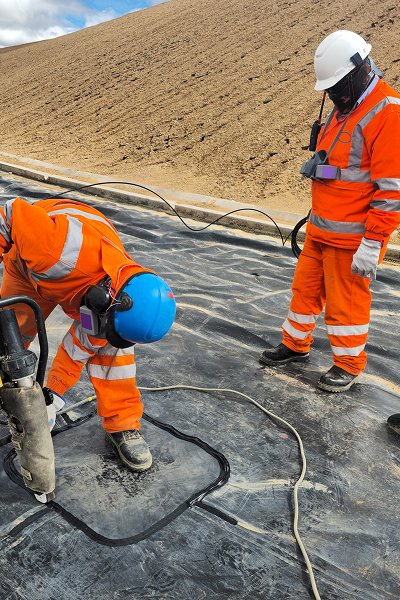How Geotube works
Water Filtration Principle: Solids and Drainage Separation
The core of Geotube lies in its "secure drainage" capability. The tube bag is filled with high-water content mud or contaminated sludge. Through the specific pore structure of the fabric, water is quickly drained away while solids are trapped within the bag.
Gravity Dewatering + Multiple Compression Mechanisms
After slurry is injected, Geotube achieves dewatering through the following mechanisms:
Weight Compression: The weight of the slurry within the bag creates a filter-pressing effect.
Filter Cloth Drainage: The permeable fabric quickly removes free water.
Chemical Additives (such as polymer flocculants) accelerate slurry-water separation and improve dewatering efficiency.
Stability and Control
The dehydrated solids remain in the tube bag, forming a stable solid structure that is not easily lost. This allows for long-term use as foundations for dams, revetments, and artificial islands.
Key issues in using Geotube
1.1 Mud Properties Determine Dewatering Efficiency
Different treatment processes (such as river sludge, industrial sludge, and tailings slurry) have varying physical properties, such as moisture content, particle size distribution, and organic matter content. These factors directly impact dewatering efficiency.
Finer particle size and higher moisture content result in slower dewatering.
High-organic-matter sludge is more difficult to compact, potentially leading to sludge retention within the filter bags.
Importance of Flocculants
To improve the speed and efficiency of solid-liquid separation, the addition of a high-molecular-weight flocculant (such as PAM) is typically required.
The mixing ratio should be determined experimentally based on the slurry's characteristics.
Insufficient or excessive addition can cause drainage problems or filter cloth clogging.
Integrating an inline mixer system is recommended for uniform mixing and real-time adjustment.
Multiple Filling and Settling Cycle Management
Geotubes are not "filled" in one go; instead, they require multiple rounds of grouting alternating with static settling.
Each round of grouting should be controlled within 60% of the bag's height to prevent cracking.
The interval between each grouting round should be adjusted based on the degree of settlement and water drainage from the previous round to ensure structural stability.
Structural Stability and Rupture Resistance Design
2.1 Internal Pressure Control and Strength Matching
Geotubes are subject to high internal pressure during the grouting process. Therefore, the following must be fully evaluated during design:
The fabric's tensile strength, seam strength, and abrasion resistance.
The maximum grouting pressure and fill rate during construction must be controlled (generally not exceeding 80% of the design height).
In actual applications, it is recommended to install an overflow port or pressure relief pipe to prevent accidental bag rupture.
Climate Adaptability
3.1 UV Aging Issues
Geotubes are primarily used outdoors. Long-term exposure to UV rays can cause material degradation, weakening, and even cracking.
Use materials with UV resistance (including UV stabilizers).
For projects with long-term exposure, it is recommended to use shade nets, mulch, or turf cover for protection.
Geotube Application Cases
River dredging sludge dewatering
Inland river black and odorous water treatment project
The efficiently dewatered sludge cake can be transferred or used for land improvement
Land reclamation and artificial island base
Airport reclamation expansion
Using Geotubes to fill soft soil areas improves construction efficiency
Dewatering of industrial tailings/wastewater ponds
Rapid consolidation of mining and paper mill sludge
Avoiding the risk of liquid tailings leakage and facilitating storage or transportation




Geotube's structural performance and dewatering efficiency are continuously being optimized. For contemporary engineering projects pursuing green and sustainable development, Geotube provides a cost-effective and eco-friendly solution.


